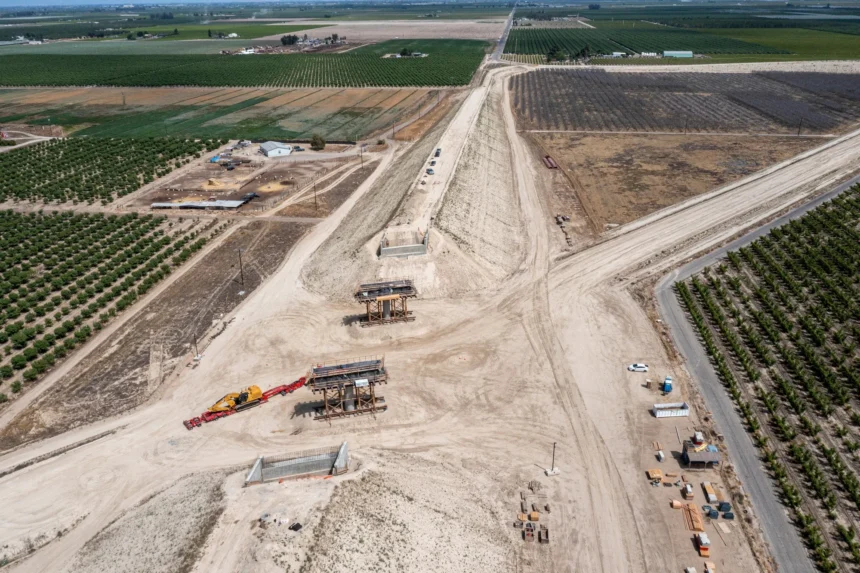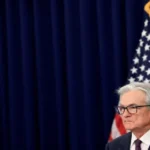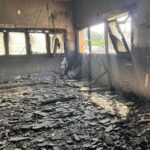WASHINGTON, D.C. – President Donald Trump has withdrawn $4 billion in federal support for California’s high-speed rail project, dealing a major setback to a long-troubled effort that has faced years of delays, rising costs, and ongoing questions about its management.
The U.S. Department of Transportation, led by Secretary Sean Duffy, confirmed the decision, leaving the project in a vulnerable spot as it struggles to find its footing under Governor Gavin Newsom, who is widely considered a possible contender for the 2028 presidential election. This loss of funding poses a new challenge for Newsom’s campaign to keep the rail effort afloat.
California High-Speed Rail’s Troubled Path
Voters approved the California High-Speed Rail in 2008 with the promise of a bullet train linking Los Angeles and San Francisco in under three hours. Project leaders said it would lower emissions, boost the economy, and create jobs. Back then, the cost was projected at $33 billion, and the opening date was set for 2020.
Seventeen years later, the situation has changed dramatically. Costs have soared to between $89 billion and $135 billion, and completion is nowhere in sight. Not a single mile of high-speed track exists. The timeline for even a shortened 171-mile section between Merced and Bakersfield has been pushed to 2033.
Instead of a full Los Angeles-to-San Francisco line, the project has been scaled back to a Central Valley segment, often labelled the “train to nowhere” by critics.
A recent 315-page report by the Federal Railroad Administration detailed missed deadlines, budget gaps, and shaky ridership estimates. The report noted a $7 billion shortfall just for the Central Valley section and accused the rail authority of having no clear plan to finish even this part on schedule. Acting FRA administrator Drew Feeley wrote that taxpayers had little to show for their $4 billion investment.
The Politics Behind Trump’s Move
Trump’s decision pulls funding from two sources: $929 million granted in 2010 and $3 billion awarded in 2023 during the Biden administration. The move is similar to Trump’s first term, when he tried to cancel almost $1 billion in grants, which were later restored after a court challenge.
Trump has often criticized the project, calling it a “waste” and blaming Governor Newsom for the ongoing problems. In a Truth Social post, Trump insisted, “Not a SINGLE penny in Federal Dollars will go towards this Newscum SCAM ever again,” using a nickname he often uses for Newsom.
Transportation Secretary Sean Duffy echoed Trump’s criticism, pointing to cost increases and calling out “waste and mismanagement.” Duffy said taxpayers had already spent $6.9 billion with no working train. The FRA has given state rail officials 37 days to respond to the findings, after which the funding cut will be final. Federal officials are also considering ways to get back money already spent.
The decision has triggered heated debate. Supporters say cutting funding could stall modern public transportation efforts in California. Critics, like Republican Congressman Kevin Kiley, believe the move is overdue and want money redirected to other needs, such as fire safety or road repairs.
Integrity and Accountability in Question
The Trump administration’s mention of “possible corruption” has reignited debate about the project’s management under California’s Democratic leadership. Newsom has defended the rail as essential for California’s future, both economically and environmentally. But some opponents claim that project decisions have been driven more by politics than by public benefit.
A key point of criticism centers on the decision to route the line through the east side of the San Joaquin Valley, which some argue benefits certain landowners and developers instead of using the more direct Interstate 5 path.
Lou Thompson, who served on the project’s peer review group, has repeatedly criticized what he calls “uncoordinated planning” and political interference. Governing magazine has also pointed to project missteps and favouritism as reasons for cost overruns.
The rail’s funding model is another source of concern. California’s cap-and-trade program, which raises money from companies trying to offset emissions, is a major backer. Newsom’s budget counts on $1 billion a year from this source through 2045, but the FRA report called this funding stream unstable and risky. Some analysts believe contracts have been steered to politically connected firms and unions, inflating costs without visible progress.
On social media, users like @TheKevinDalton have called the rail a “money laundering operation,” while @libsoftiktok has slammed it as a “failed” project. While there is no solid proof behind these claims, the public’s faith in the rail authority has faded.
Legal experts say proving wrongdoing is difficult. Georgetown law professor Eloise Pasachoff noted that California could challenge the funding cut in court as “arbitrary and capricious,” though political clashes alone likely won’t win a legal case. David Freeman Engstrom of Stanford suggests the decision might be seen as a move to damage Newsom politically, but that argument isn’t likely to sway judges.
Newsom Faces New Risks
Governor Newsom has made support for the high-speed rail a key part of his agenda. In January 2025, he visited Bakersfield to highlight construction work and pushed for $1 billion per year in new funding. Newsom has promised to fight the federal cut in court, calling the move “illegal.”
Still, the project’s ongoing problems could hurt his standing as he looks to 2028. Trump and other critics have tied the rail’s failures directly to Newsom’s leadership and say it could make him “unelectable.”
Even some Democrats, like former State Assembly Speaker Anthony Rendon, have lost confidence in the rail. With California facing a $12 billion deficit, Newsom’s push for more rail spending could turn off voters who want to focus on more immediate issues like wildfire response or budget discipline.
What’s Next for the Project?
Despite setbacks, the California High-Speed Rail Authority remains hopeful. CEO Ian Choudri calls the FRA’s report “misguided” and says the project has made real progress, including 119 miles of ongoing construction in the Central Valley.
The authority plans to start laying tracks in 2026 and is seeking private partners to help close the funding gap. Without federal help, though, the project faces tough odds. The state’s Legislative Analyst’s Office warns that current funding may only last another 15 months.
Democrats, with strong backing from labour unions, are pushing to secure more stable funding from the cap-and-trade program. State Senate Budget Chair Scott Wiener says the rail is important for California’s economy and environment and argues for more efficient management.
Opponents like Tony Strickland would rather see the money go toward lowering gas prices or other infrastructure. They point to private projects like Brightline West, linking Las Vegas and Southern California, as examples of how the private sector can deliver rail projects more successfully.
What the Rail Project Means Now
California’s high-speed rail now stands at a turning point. Supporters still see it as a bold step toward greener travel, while critics view it as proof of government waste and poor planning. With Trump’s funding cut in play, the project’s future and Newsom’s political legacy are deeply connected. If California manages to finish the train, it would mark a major achievement. If not, critics will likely remember it as an expensive promise that never delivered.
As the state prepares to challenge the funding cut, the fight over high-speed rail has become a symbol of larger battles over public spending and political rivalry. The outcome could have a lasting effect on California’s future and the way America thinks about big public works during tight budget times.











